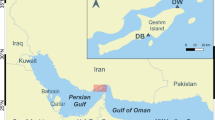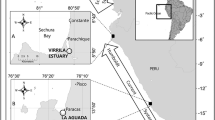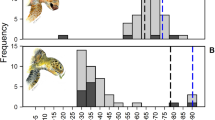Abstract
Understanding resource use and foraging requirements is important for the recovery of threatened and endangered marine turtles. Throughout their range, an increasing number of juvenile green turtles (Chelonia mydas) has been observed foraging and sheltering within man-made structures. These “artificial habitats” are ecologically important as they support the growth of attached macroalgae, a primary food resource of juvenile green turtles. A population of juvenile green turtles in the Trident Basin at Port Canaveral, Florida, USA (28.41°N, 80.59°W), has historically exhibited strong site fidelity. The purpose of this study was to compare the foraging of juvenile green turtles with the availability of macroalgal resources. Foraging (lavage) samples from 94 juvenile green turtles during a 2-year study period from September 2008 through April 2010 were analyzed with the data from two previous studies (1997 and 2002) to determine the patterns of foraging habits through time. Turtles predominantly foraged on species of red (Rhodophyta) and green (Chlorophyta) macroalgae; however, opportunistic foraging on flotsam and invertebrates was common. Selection for certain rhodophytes (i.e., Gelidiopsis planicaulis, Grateloupia filicina, and Hypnea spinella) and chlorophytes (i.e., Cladophora liniformis, Ulva flexuosa, U. lactuca, and U. prolifera) varied by sampling period. Temperature-driven changes in the macroalgal species composition drove inter-annual differences in foraging content between 2002 and 2010. In addition, after an extended cold event, foraging samples from several turtles contained macroalgae not present in the Basin which suggested that turtles moved out of the Basin to forage during this time or newly emigrated. Establishing baseline resource utilization is instrumental for identifying the quality and function of natural and artificial habitats supporting juvenile green turtles, as their populations continue to recover around the globe.



Similar content being viewed by others
References
Airoldi L (2001) Distribution and morphological variation of low-shore algal turfs. Mar Biol 138:1233–1239. doi:10.1007/s002270100546
Airoldi L, Abbiati M, Beck MW, Hawkins SJ, Jonsson PR, Martin D, Moschella PS, Sundelof A, Thompson RC, Åberg P (2005) An ecological perspective on the deployment and design of low-crested and other hard coastal defence structures. Coast Eng 52:1073–1087. doi:10.1016/j.coastaleng.2005.09.007
Arthur KE, Balazs GH (2008) A comparison of immature green turtle (Chelonia mydas) diets among seven sites in the main Hawaiian Islands. Pac Sci 62:205–217. doi:10.2984/1534-6188(2008)62[205:ACOIGT]2.0.CO;2
Bagley DA (2003) Characterizing juvenile green turtles (Chelonia mydas), from three east central Florida developmental habitats. Master’s, University of Central Florida
Balazs GH (1980) Field methods for sampling the dietary components of green turtles Chelonia mydas. Herpetol Rev 11:5–6
Bjorndal KA (1980) Nutrition and grazing behavior of the green turtle Chelonia mydas. Mar Biol 56:147–154. doi:10.1007/BF00397131
Bjorndal KA (1999) Priorities for research in foraging habitats. In: Eckert KL, Bjorndal KA, Abreu-Grobois FA, Donnelly M (eds) Research and management techniques for the conservation of sea turtles. 4th edn. IUCCN/SSC Mar Turtle Spec Group Publ No 4, Washington, DC, pp 1–3
Bjorndal KA, Bolten AB, Lagueux CJ (1994) Ingestion of marine debris by juvenile sea turtles in coastal Florida habitats. Mar Pollut Bull 28:154–158. doi:10.1016/0025-326X(94)90391-3
Bjorndal KA, Bolten AB, Chaloupka M, Saba VS, Bellini C, Marcovaldi MA, Santos AJ, Bortolon LFW, Meylan AB, Meylan PA et al (2017) Ecological regime shift drives declining growth rates of sea turtles throughout the West Atlantic. Glob Change Biol. doi:10.1111/gcb.13712
Brand-Gardner SJ, Lanyon JM, Limpus CJ (1999) Diet selection by immature green turtles, Chelonia mydas, in subtropical Moreton Bay, south-east Queensland. Aust J Zool 47:181–191. doi:10.1071/ZO98065
Bresette M, Gorham J, Peery B (1998) Site fidelity and size frequencies of juvenile green turtles (Chelonia mydas) utilizing near shore reefs in St. Lucie County, Florida. Mar Turtle Newsl 82:5–7
Clarke KR, Green RH (1988) Statistical design and analyses for a ‘biological effects’ study. Mar Ecol Prog Ser 46:213–226. doi:10.3354/meps046213
Clarke KR, Warwick RM (2001) Change in marine communities: an approach to statistical analysis and interpretation, 2nd edn. PRIMER-E Ltd., Plymouth PL
Connell S, Foster M, Airoldi L (2014) What are algal turfs? Towards a better description of turfs. Mar Ecol Prog Ser 495:299–307. doi:10.3354/meps10513
Cserháti T, Forgács E, Oros G (2002) Biological activity and environmental impact of anionic surfactants. Environ Int 28:337–348. doi:10.1016/S0160-4120(02)00032-6
Ehrhart LM, Ogren LH (1999) Studies in foraging habitats: capturing and handling turtles. In: Eckert KL, Bjorndal KA, Abreu-Grobois FA, Donnelly M (eds) Research and management techniques for the conservation of sea turtles. 4th edn. IUCCN/SSC Mar Turtle Spec Group Publ No 4, Washington, DC, pp 61–64
Ehrhart LM, Redfoot WE, Bagley DA (1996) A study of the population ecology of the in-water marine turtle populations on the east-central Florida coast from 1982–96. NOAA/NMFS/SEFC, Miami
Forbes GA (1999) Diet sampling and diet component analysis. In: Eckert KL, Bjorndal KA, Abreu-Grobois FA, Donnelly M (eds) Research and management techniques for the conservation of sea turtles, 4th edn. SSC/IUCCN Marine Turtle Specialist Group, Washington, DC, pp 144–148
Forbes GA, Limpus LJ (1993) A non-lethal method for retrieving stomach contents from sea turtles. Aust Wildlife Res 20:339–343. doi:10.1071/WR9930339
Fourqurean JW, Manuel S, Coates KA, Kenworthy W, Smith SR (2010) Effects of excluding sea turtle herbivores from a seagrass bed: overgrazing may have led to loss of seagrass meadows in Bermuda. Mar Ecol Prog Ser 419:223–232. doi:10.3354/meps08853
Hirth HF (1997) Synopsis of the biological data on the green turtle Chelonia mydas (Linnaeus 1758). Fish and Wildlife Service US DOI, Washington, DC
Holloway-Adkins KG (2001) A comparative study of the feeding ecology of Chelonia mydas (green turtle) and the incidental ingestion of Prorocentrum spp. University of Central Florida, Master’s
Holloway-Adkins KG (2006) Juvenile green turtle (Chelonia mydas) foraging on a high-energy, shallow reef on the east coast of Florida. In: Frick M, Panagopoulou A, Rees AF, Williams K (eds) Twenty-Sixth Annual Symposium on Sea Turtle Biology and Conservation. International Sea Turtle Society, Athens
Holloway-Adkins KG, Hanisak MD (2015) Macroalgal community within a warm temperate/subtropical biogeographic transition zone in the western Atlantic Ocean. Bull Mar Sci 91:295–319. doi:10.5343/bms.2014.1008
Holloway-Adkins KG, Provancha JA (2005) Abundance and foraging activity of marine turtles using nearshore rock resources along the Mid Reach of Brevard County, Florida. Brevard County, Jacksonville
Howell LN, Reich KJ, Shaver DJ, Landry AM Jr, Gorga CC (2016) Ontogenetic shifts in diet and habitat of juvenile green sea turtles in the northwestern Gulf of Mexico. Mar Ecol Prog Ser 559:217–229. doi:10.3354/meps11897
Hurd CL (2000) Water motion, marine macroalgal physiology, and production. J Phycol 36:453–472. doi:10.1046/j.1529-8817.2000.99139.x
Krebs CJ (1989) Ecological methodology, 1st edn. Harper-Collins Publishers, New York
Kubis SA, Chaloupka M, Ehrhart L, Bresette M (2009) Growth rates of juvenile green turtles, Chelonia mydas, from three ecologically distinct foraging habitats along the east central coast of Florida, USA. Mar Ecol Prog Ser 389:257–269. doi:10.3354/meps08206
Lal A, Arthur R, Marbà N, Lill AWT, Alcoverro T (2010) Implications of conserving an ecosystem modifier: increasing green turtle (Chelonia mydas) densities substantially alters seagrass meadows. Biol Conserv 143:2730–2738. doi:10.1016/j.biocon.2010.07.020
LeónY M, Bjorndal KA (2002) Selective feeding in the hawksbill turtle, an important predator in coral reef ecosystems. Mar Ecol Prog Ser 245:249–258. doi:10.3354/meps245249
Lutz, PL (1990) Studies on the ingestion of plastic and latex by sea turtles. In: Shomura, RS, Yoshida, HO (eds) Proceedings of the workshop on the fate and impact of marine debris. Honolulu, pp 719–735
Makowski C, Seminoff JA, Salmon M (2006) Home range and habitat use of juvenile Atlantic green turtles (Chelonia mydas L.) on shallow reef habitats in Palm Beach, Florida, USA. Mar Biol 148:1167–1179. doi:10.1007/s00227-005-0150-y
McCauley SJ, Bjorndal KA (1999) Conservation implications of dietary dilution from debris ingestion: sublethal effects in post-hatchling loggerhead sea turtles. Conserv Biol 13:925–929. doi:10.1046/j.1523-1739.1999.98264.x
McDermid KJ, Stuercke B, Balazs GH (2007) Nutritional composition of marine plants in the diet of the green sea turtle (Chelonia mydas) in the Hawaiian Islands. Bull Mar Sci 81:55–71
Metz TL, Landry AM Jr (2013) An assessment of green turtle (Chelonia mydas) stocks along the Texas Coast, with emphasis on the Lower Laguna Madre. Chelonian Conserv Bi 12:293–302. doi:10.2744/CCB-1046.1
Moran KL, Bjorndal KA (2005) Simulated green turtle grazing affects structure and productivity of seagrass pastures. Mar Ecol Prog Ser 305:235–247. doi:10.3354/meps305235
Moran KL, Bjorndal KA (2007) Simulated green turtle grazing affects nutrient composition of the seagrass Thalassia testudinum. Mar Biol 150:1083–1092. doi:10.1007/s00227-006-0427-9
Mortimer JA (1981) The feeding ecology of the west Caribbean green turtle (Chelonia mydas) in Nicaragua. Biotropica 13:49–58. doi:10.2307/2388071
Musick JA, Limpus CJ (1997) Habitat utilization and migration in juvenile sea turtles. In: Lutz P, Musick J (eds) The biology of sea turtles. Marine Science Series. CRC Press, Boca Raton, pp 137–163
National Marine Fisheries Service and US Fish and Wildlife Service (1991) Recovery Plan for US Population of Atlantic Green Turtle. National Marine Fisheries Service, Silver Spring, MD
National Marine Fisheries Service and US Fish and Wildlife Service (1998a) Recovery Plan for US Pacific Populations of the East Pacific Green Turtle (Chelonia mydas). National Marine Fisheries Service, Silver Spring, MD
National Marine Fisheries Service and US Fish and Wildlife Service (1998b) Recovery Plan for US Pacific Populations of the Green Turtle (Chelonia mydas). National Marine Fisheries Service, Silver Spring, MD
NOAA-NCDC (2016) 2009/2010 Cold season significant events. NOAA. ftp://ftp.ncdc.noaa.gov/pub/data/extremeevents/specialreports/2009-2010-Cold-Season.pdf. Accessed 16 May 2017
Redfoot WE (1997) Population structure and feeding ecology of green turtles utilizing the Trident Submarine Basin, Cape Canaveral, Florida as developmental habitat. Master’s, University of Central Florida
Redfoot WE, Ehrhart LM (2013) Trends in size class distribution, recaptures, and abundance of juvenile green turtles (Chelonia mydas) utilizing a rock riprap lined embayment at Port Canaveral, Florida, USA as developmental habitat. Chelonian Conserv Bi 12:252–261. doi:10.2744/CCB-0952.1
Reich KJ, Bjorndal KA, Bolten AB (2007) The ‘lost years’ of green turtles: using stable isotopes to study cryptic lifestages. Biol Lett 3:712–714. doi:10.1098/rsbl.2007.0394
Reisser J, Shaw J, Wilcox C, Hardesty BD, Proietti M, Thums M, Pattiaratchi C (2013) Marine plastic pollution in waters around Australia: characteristics, concentrations, and pathways. PLoS One 8:3169–3179. doi:10.1007/s00227-013-2304-7
Rincon-Diaz MP, Diez CE, Van Dam RP, Sabat AM (2011) Effect of food availability on the abundance of juvenile hawksbill sea turtles (Eretmochelys imbricata) in inshore aggregation areas of the Culebra Archipelago, Puerto Rico. Chelonian Conserv Bi 10:213–221. doi:10.2744/CCB-0920.1
Russell DJ, Balazs GH (2009) Dietary shifts by green turtles (Chelonia mydas) in the Kāne‘ohe Bay Region of the Hawaiian Islands: a 28-year study. Pac Sci 63:181–192. doi:10.2984/049.063.0202
Schuyler Q, Hardesty BD, Wilcox C, Townsend K (2012) To eat or not to eat? Debris selectivity by marine turtles. PLoS One 7:e40884. doi:10.1371/journal.pone.0040884
Seminoff JA, Resendiz A, Nichols WJ (2002) Diet of East Pacific green turtles (Chelonia mydas) in the Central Gulf of California, Mexico. J Herpetol 36:447–453. doi:10.1670/0022-1511(2002)036%5B0447:DOEPGT%5D2.0.CO;2
Shamblin BM, Bjorndal KA, Bolten AB, Hillis-Starr ZM, Lundgren I, Naro-Maciel E, Nairn CJ (2012) Mitogenomic sequences better resolve stock structure of southern Greater Caribbean green turtle rookeries. Mol Ecol 21:2330–2340. doi:10.1111/j.1365-294X.2012.05530.x
Strauss RE (1979) Reliability estimates for Ivlev’s Electivity Index, the forage ratio, and a proposed linear index of food selection. Trans Am Fish Soc 108:344–352. doi:10.1577/1548-8659(1979)108%3C344:REFIEI%3E2.0.CO;2
US Fish and Wildlife Service and National Oceanic and Atmospheric Administration Fisheries (1978) Endangered Species Act 1973 | 1978 ESA Amendment. Environmental Conservation Online System, Washington, DC
Vander Zanden HB, Bjorndal KA, Bolten AB (2013) Temporal consistency and individual specialization in resource use by green turtles in successive life stages. Oecologia 73:767–777. doi:10.1007/s00442-013-2655-2
Witherington BE, Hirama S, Hardy R (2012) Young sea turtles of the pelagic Sargassum-dominated drift community: habitat use, population density, and threats. Mar Ecol Prog Ser 463:1–22. doi:10.3354/meps09970
Acknowledgements
Access to publicly restricted areas of CCAFS and Trident Basin was granted by US Air Force—45th Space Wing and US NAVY. Special thanks to D.George and A. Chambers for their reviews of materials and M Carroll and M O’Quinn for assistance with site accessibility. Many thanks to L. Ehrhart, W. Redfoot, and UCF’s Marine Turtle Research Group for many hours of netting turtles in all conditions. W. Redfoot was most gracious to allow us to incorporate part of his Master’s work dataset for our comparative analyses. We thank C. Garreau-Bourtis, E. Reyier, D. Scheidt, S. Gann, R. Lowers, and C. Hall for field support. Dynamac and IHA provided time and materials for this project. We appreciate the assistance of W. Freshwater (University of North Carolina, Wilmington) in identification of difficult Gelidiales species. Thank you to my dissertation committee members, L. Ehrhart, C. E. Proffitt, T. Sutton, and R. Virnstein, for their guidance and contributions to the original proposed project and final manuscript review. Thank you to T. Kozusko for help with map creation and M. Mota for comments and review. We want to thank L. Avens (editor), L. Howell and E. Seney (expert reviewers) of this journal for their comments and suggestions that improved the manuscript. This is Harbor Branch Contribution #2082.
Author information
Authors and Affiliations
Corresponding author
Ethics declarations
Conflict of interest
The authors declare that they have no conflicts of interest.
Ethical standards
All applicable federal, state, and institutional guidelines for the care and use of animals were followed. All research activities were permitted by Florida Fish and Wildlife Conservation Commission (Marine Turtle permit # 25) and National Marine Fisheries (NOAA-NMFS # 14506), and in compliance with University of Central Florida IACUC # 08-51 W.
Additional information
Responsible Editor: L. Avens.
Reviewed by: L. Howell and E. Seney.
Rights and permissions
About this article
Cite this article
Holloway-Adkins, K.G., Dennis Hanisak, M. Macroalgal foraging preferences of juvenile green turtles (Chelonia mydas) in a warm temperate/subtropical transition zone. Mar Biol 164, 161 (2017). https://doi.org/10.1007/s00227-017-3191-0
Received:
Accepted:
Published:
DOI: https://doi.org/10.1007/s00227-017-3191-0




